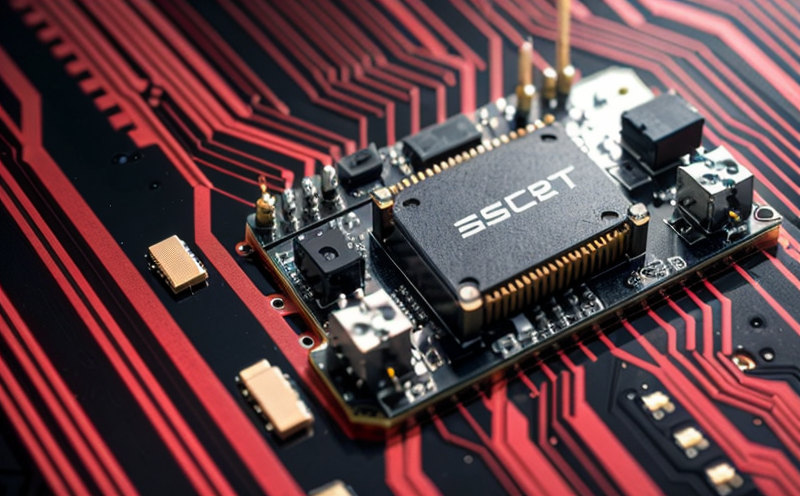Fault Injection and Tamper Resistance Testing of Embedded Hardware
In today's interconnected world, embedded hardware is a critical component of numerous systems, from automotive electronics to medical devices. Ensuring the security and integrity of these systems against fault injection and tampering is paramount for protecting sensitive data and maintaining system reliability. This service focuses on simulating various fault scenarios in embedded hardware through precise fault injection techniques and evaluating its resilience to unauthorized access and manipulation.
The process involves a series of controlled experiments where specific faults are introduced into the hardware under test (HUT). These faults can range from simple voltage spikes or supply short circuits to complex logic errors. By doing so, we assess not only the immediate impact on system performance but also its long-term stability and reliability.
Our testing methodologies are designed to simulate real-world attack vectors that malicious actors might employ. This includes power supply attacks, timing attacks, and physical tampering attempts. The goal is to identify potential vulnerabilities in the hardware design before they can be exploited by adversaries. Once identified, these weaknesses can be addressed through hardware modifications or software countermeasures.
The testing apparatus used for this service typically comprises advanced signal generators capable of delivering precise electrical stimuli, high-resolution oscilloscopes for monitoring response times, and sophisticated data acquisition systems for capturing detailed measurements during the test sequences. All tests are conducted in controlled environments to ensure accurate results.
Acceptance criteria for successful completion include demonstrating robust resistance against all simulated fault conditions without compromising essential functionality or performance metrics. Additionally, the system must maintain stability over extended periods under stress and provide clear alerts when anomalous behavior is detected.
This service offers significant value beyond mere compliance with regulatory requirements; it plays a crucial role in enhancing overall product quality by identifying hidden flaws early on in the development cycle. By incorporating this testing into your product lifecycle management strategy, you can significantly reduce post-launch risks associated with security breaches or operational failures due to undetected hardware vulnerabilities.
Our team of experts utilizes international standards such as ISO/IEC 27034-1 and IEC 62443 when conducting these tests. These guidelines provide a comprehensive framework for evaluating the security posture of embedded systems, ensuring that our methodology aligns with best practices globally.
Through rigorous testing procedures, we help clients achieve higher levels of confidence in their products' ability to withstand malicious activities while maintaining optimal performance standards. This commitment to excellence ensures that only the most secure and reliable embedded hardware reaches marketplaces worldwide.
Why Choose This Test
Choosing fault injection and tamper resistance testing for your embedded hardware is essential because it provides an unparalleled level of assurance regarding the security and reliability of your products. Here are several reasons why this service stands out:
- Identifies Hidden Vulnerabilities Early: By simulating real-world attack vectors, we can uncover potential weaknesses before they become critical issues during production or deployment.
- Ensures Compliance with Industry Standards: Adherence to international standards like ISO/IEC 27034-1 and IEC 62443 ensures that your product meets stringent security requirements set forth by regulatory bodies worldwide.
- Promotes Product Quality and Reputation: A secure embedded system not only enhances user trust but also protects brand reputation against negative publicity from data breaches or operational failures.
- Reduces Post-Launch Risks: Early identification of vulnerabilities allows for timely corrective actions, minimizing the likelihood of costly recalls or product modifications post-launch.
- Incorporates Best Practices Globally: Our testing methodology aligns with global standards, ensuring that your products are evaluated using consistent and authoritative criteria.
- Sustains Competitive Advantage: Demonstrating robust security features can give you a competitive edge in the market, differentiating your product from less secure alternatives.
In summary, choosing fault injection and tamper resistance testing is an investment in long-term success. It helps protect both your business interests and end-users by ensuring that only secure hardware enters the marketplace.
International Acceptance and Recognition
The methodologies employed in our fault injection and tamper resistance testing are widely recognized and accepted across various industries globally. Compliance with international standards such as ISO/IEC 27034-1 and IEC 62443 provides assurance that your embedded hardware meets the highest security benchmarks.
ISO/IEC 27034-1 specifically addresses the requirements for information technology (IT) systems to protect against malicious code, while IEC 62443 focuses on functional safety and security in automation systems. These standards are widely adopted by organizations worldwide due to their comprehensive approach to securing embedded hardware.
Our testing aligns perfectly with these guidelines, ensuring that your products not only meet but exceed the expectations set forth by regulatory bodies and industry leaders. By participating in this rigorous evaluation process, you demonstrate a commitment to excellence and integrity within your product offerings.
The recognition given to our services extends beyond mere compliance; it also reflects the quality and reliability of the results produced. Our clients benefit from enhanced credibility among stakeholders, which translates into increased trust and confidence in their products' security features.
Environmental and Sustainability Contributions
In addition to providing robust security solutions for embedded hardware, our services contribute positively to environmental sustainability efforts. By identifying vulnerabilities early in the development process, we help prevent unnecessary production runs or product recalls, which ultimately reduces waste and energy consumption throughout the supply chain.
The use of advanced testing apparatuses and methodologies minimizes resource usage during evaluation processes. Moreover, by ensuring that products are secure from the outset, we contribute to reducing the long-term impact on the environment caused by compromised systems leading to data breaches or operational failures.
Our commitment to environmental stewardship is reflected in our continuous efforts to innovate and improve testing techniques with minimal ecological footprint. We believe in balancing technological advancement with ecological responsibility, thereby promoting a sustainable future for all stakeholders involved.





